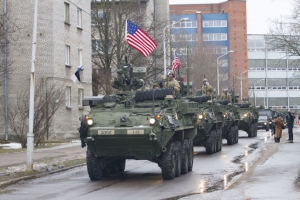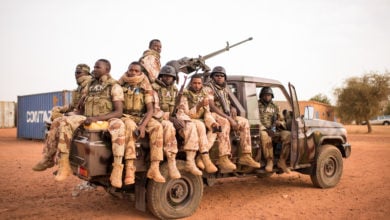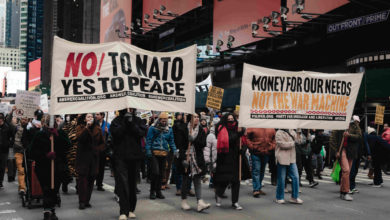
On May 3, U.S. Secretary of Defense Ash Carter, in Germany for a NATO ceremony, accused Russia of “nuclear saber-rattling.” A very serious claim, if true. Carter said, “Moscow’s nuclear saber-rattling raises troubling questions about Russia’s leaders’ commitment to strategic stability.”
This statement came right on the heels of the revelation that NATO is developing plans to station 4,000 troops in Poland and the Baltic states right on the border with Russia. Part of the plan may include installing a German battalion on a border with Russia. Stationing U.S. and NATO troops on the border of Russia, especially if Germany were to set up a permanent base, would be a very serious provocation.
The misleading accusation that Russia is using its nuclear arsenal to destabilize Europe is an amazing distortion of reality and must be called out for what it is, an attempt on the part of the United States to dress up an offensive maneuver—massing fighting forces on a country’s border—as a defensive maneuver.
The State Department and the Pentagon have also used as justification for the troop buildup a recent incident in which a Russian jet flew over a U.S. warship in the Baltic Sea. The U.S. media characterized it as “provocative” and “aggressive.” This is a ridiculous interpretation.
The U.S. warship was a guided-missile destroyer, the USS Donald Cook. The Baltic Sea borders Russia. Let’s think this through. If a Russian guided-missile destroyer was “patrolling” in the Gulf of Mexico, wouldn’t the U.S. military dispatch warplanes (and perhaps much more) to intercept the destroyer? In fact, let’s be honest, the U.S. military would most likely either assault, capture or destroy a Russian warship that merely attempted to enter the Gulf of Mexico, whether or not Mexico invited the ship. The U.S. would say that the very existence of the warship in the gulf was an act of aggression.
Make no mistake, although the United States and Russia are not at war, every maneuver by a U.S. destroyer is carrying out a military strategy. The USS Donald Cook is armed with cruise missiles. You don’t simply send a destroyer on a random mission. Why else would you send a “patrol” within striking distance of Russian cities during a time of heightened tensions other than to send a forceful message to Moscow? It’s obvious. Sending the warship is an aggressive action aimed at Russia.
Russia has responded to U.S. provocations with plans to shift more troops to the border and with plans to create three more military divisions.
Russian Foreign Minister Sergey Lavrov has said, “NATO military infrastructure is inching closer and closer to Russia’s borders. But when Russia takes action to ensure its security, we are told that Russia is engaging in dangerous maneuvers near NATO borders. In fact, NATO borders are getting closer to Russia, not the opposite.”
U.S. responsible for major powers climbing the ladder of escalation
There is no simplistic dynamic in the deteriorating relations between the United States and Russia, but let’s be clear. It is not Russia that is encircling the United States with missile batteries and troops. It is the United States that is encircling Russia with missile batteries and troops. It isn’t Russia that wages war on the U.S. economy. The exact opposite is true.
It isn’t Russia that is carrying out a series of military exercises all along the U.S. border that simulate the invasion of the United States. The exact opposite is true.
It wasn’t Russia that helped overthrow the Ukrainian government alongside fascists and hard-right groupings in 2014. That was the United States. In Crimea, which left Ukraine after the coup and rejoined Russia, Russia acted to maintain its only warm water naval port in Sevastopol. For Russia, it was an existential necessity to reincorporate Crimea.
It was the United States that destroyed Iraq, Libya and helped to destroy vast parts of Syria, making possible the rise of ISIS. Russia, on the contrary, has intervened in Syria to help stabilize Syria and defeat ISIS and Al Qaeda.
This list could be much, much longer. But it all breaks down to this: In reality, the United States is the aggressor while presenting Russia as the aggressor. Washington and the Pentagon are conveying to the people of the United States an entirely upside down version of reality.
According to polls, a big majority of the people in Germany and France are very opposed to stationing NATO troops on the border of Russia.
In Poland, where 80 percent of the population has a negative view of Russia, Polish foreign minister Witold Waszczykowski believes that Russia is a greater threat than ISIS! The leaders of Poland and the Baltic states are actively seeking the stationing of NATO troops in their countries, not out of any direct threat that Russia has made to their sovereignty, but out of a die-hard anti-Russian orientation. The elites in those countries have long sought the diminution or destruction of Russia. In fact, Russia is not at all an immediate military threat to any country.
In the United States, we must not only see the conflict between Russia and the United States with clarity, we must also act to prevent a larger war. You do not need to be a supporter of the Russian government to understand Russia’s reasonable attempts to defend its sovereignty. This is clearly not a case where there is equal blame on both sides in the ramping up of a confrontation that could quickly spiral out of control.
Though it is a relatively strong country, Russia is being targeted—not for any reactionary policies—but for drawing existential lines in the sand that have, in some cases, made it harder for U.S. imperialism to bully other countries and to unilaterally set the agenda for the rest of the world. The only sense in which Russia is a threat to the United States or Europe is that it is not willing to give up the entire planet to United States in each and every situation. In that vein, Russia is certainly talking and acting tougher and even being more proactive in its plans and actions.
The type of machinations that are happening right now in Eastern Europe are precisely the types of things that happened in the years preceding both world wars. It is impossible to understate how much another world war would be a calamity of unprecedented proportions. If any country on the planet is the most responsible for tensions among major powers and for exacerbating conflict, it is the United States. It is not hyperbole to say that the fate of the human race relies on us bringing the era of imperialism to a conclusion and ushering in a new era guided by the principles of cooperation and genuine equality between nations. This era of deceitful warmongers and one country hegemony needs to be forcefully brought to an end.
As the world this week celebrates the 71st anniversary of the end of World War II, a war in which at least 50 million people perished needlessly, the progressive and socialist forces of the world must build a movement to resist another war between major powers—must urgently build a movement to end all wars once and for all.





